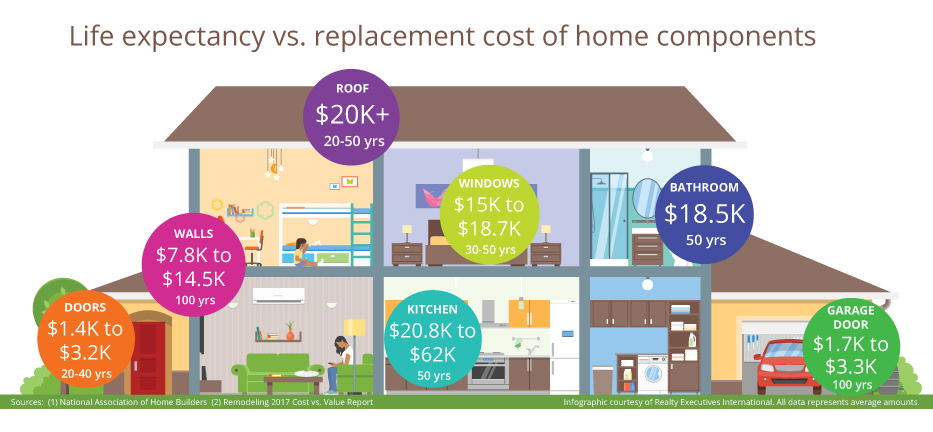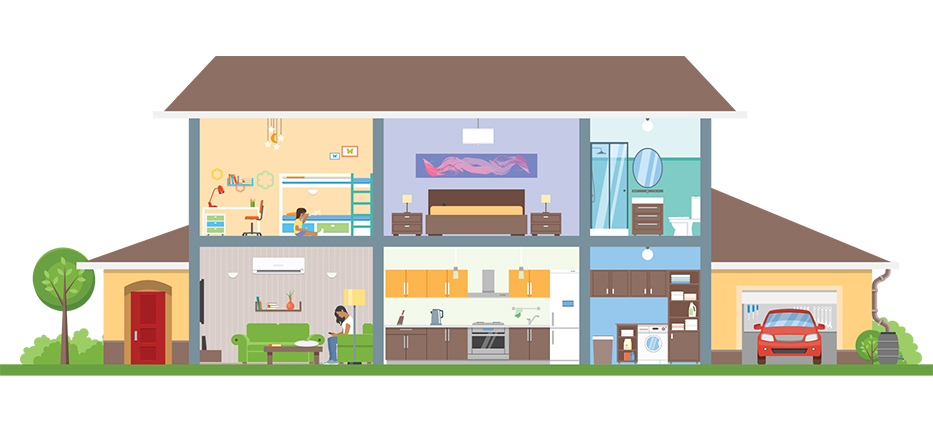A well-constructed home can last for hundreds of years. But maintenance, climate and home innovation can all impact how long the components of that home stay useful. However, eventually things wear out, so with help from the National Association of Home Builders we’re going room-by-room to tell you how much time you have before you’ll have to replace different parts of your home.
Exterior
Expect the doors that lead to the front or back of your home to last 20 to 40 years due to their exposure to weather conditions and heavy daily use. “With regards to climate, humid, wet environments, or worse, salty humid environments tend to take a toll on housing and components,” says Jessica Boudreaux of Boudreaux Design Studio. “Any sign of disrepair, such as pooling water, a leak, or warped wood, should be addressed quickly. The longer they sit, the more expensive they are to repair.”
Living rooms and dens
Chimneys and fireplaces are constructed with durability in mind, so the brick or concrete used for these features commonly last for a century. Windows can last between 15 and 30 years, for aluminum or wooden windows respectively.
Kitchen
Kitchen sinks and cabinetry can last up to 50 years, while faucets are functional for up to 15 years. However, this varies depending on the materials used. For example, rock kitchen cabinets are expected to last as long as your home.
Appliance lifespans are harder to nail down. In general, technological advancements and a wide variety of use between homes means appliances tend to get replaced before they are worn out. However, major home appliances tend to last around a decade, including gas ranges (15 years), refrigerators (13 years), and microwaves and dishwashers (9 years).
John Bodrozic, co-founder of home maintenance tracking app HomeZada, notes that you can extend the life of appliances and other items by developing a home maintenance schedule. “Staying on top of preventative maintenance tasks not only preserves the life of the home’s materials, it can also reduce the monthly energy bills by keeping things running as efficiently as possible, and keep the home running in a safe and healthy manner,” he says.

Bathroom
Bathroom sinks are similar to kitchen sinks in their lifespan, you might need a new one every 50 years. The same goes for any enclosures around your shower. Showerheads, however, should not need replacing at all if properly maintained.
Whirlpool tubs can last up to 50 years, but they will need to be checked (along with any glass shower doors) at the 20-year mark. Medicine cabinets should be checked at this time as well.
As for toilets, the tank and bowl can get porcelain cracks but should last a lifetime, whereas the components inside the tank will need maintenance to remain in order.
Laundry room
The cabinetry in the laundry room is also built for the long-term. Expect 100 or more years of life out of those installations. Washers and dryers are much like dishwashers, though, with an average lifespan of nine years.
Garage
A place for storage as much as it is for cars, garage cabinetry is an important part of a home. Cabinetry designed to hold power tools, gardening mulch, sporting equipment and a variety of other useful items will carry you far past your mortgage length: 100 years.
Check openers every 15 years or so, around the same time you check your furnaces and water heaters, too.
Electrical and foundation
Check once a decade on any and all electrical fixtures in the home. Make sure that along with routine maintenance, the heating, ventilation, and air conditioning (HVAC) system in your home gets changed every 15 to 25 years.
As for the foundation, it should be solid as a rock if the right homebuilder was involved. But check for any termite infestations or damage from water pooling to ensure the walls and foundation stay solid.

